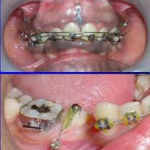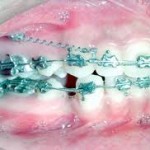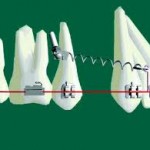The high level of stability gained from the types of implants placed in retromolar or midpalatal regions is derived largely from the fact that the implants are osseointegrated. Initial concerns about disruption of osseointegration by orthodontic loading were proven to be unfounded by several studies.
 Roberts and colleagues reported using two-stage conventional titanium implants in the retromolar region to help augment anchorage while protracting molars to close extraction sites. The implants were removed using a trephine following the conclusion of orthodontic treatment and were subsequently histologically analyzed. Roberts and colleagues found that approximately 80% of the endosseous portions of the implants were in direct contact with mature bone. Thus, this case study indicated that a relatively high level of osseointegration was maintained despite loading the implant with orthodontic forces.
Roberts and colleagues reported using two-stage conventional titanium implants in the retromolar region to help augment anchorage while protracting molars to close extraction sites. The implants were removed using a trephine following the conclusion of orthodontic treatment and were subsequently histologically analyzed. Roberts and colleagues found that approximately 80% of the endosseous portions of the implants were in direct contact with mature bone. Thus, this case study indicated that a relatively high level of osseointegration was maintained despite loading the implant with orthodontic forces.
Another study by Turley and colleagues also pointed to the stability of two-stage titanium implants used for orthodontic traction in dogs. A later study by Wehrbein and colleagues used the Straumann Orthosystem (Straumann Holding AG, Basel, Switzerland) in midpalatal and retromolar areas in humans for anchorage purposes. The implants were subjected to continuous orthodontic loading and were removed and analyzed following treatment. The findings from the histologic evaluation of the include conventional titanium endosseous dental implants, palatal implants (such as onplants and the Straumann Orthosystem [Andover, MA, USA]), titanium miniscrews (also known as micro- or miniimplants), and mini–bone plates.
Conventional Implants
Conventional titanium endosseous dental implants can be used as sources of absolute or direct anchorage for orthodontic treatment. This approach can be used when edentulous spaces exist within an arch and adjacent or opposing teeth are not positioned ideally. In such cases when the restorative treatment plan involves a dental implant, it may be beneficial to use the implant itself as anchorage for treating concomitant orthodontic problems. In 1991 Higuchi and Slack reported correcting malocclusions in seven adults using Brånemark implants as sources of direct anchorage. Later Schweizer and colleagues reported the use of conventional endosseous implants in orthodontic therapy in 1996. The authors stressed the importance of double use (combined orthodontic and prosthodontics treatment modalities) of the implant system because once the implant has been placed, no movement will occur owing to osseointegration.
 In 1995 Smalley noted the importance of using a pretreatment diagnostic wax-up to aid in the precise placement of implant(s) prior to orthodontic treatment. This implants indicated that they had been well integrated, again despite orthodontic loading. It seems apparent that when subjected to the relatively low continuous forces that are used in orthodontic therapy, implants have little difficulty maintaining osseointegration.
In 1995 Smalley noted the importance of using a pretreatment diagnostic wax-up to aid in the precise placement of implant(s) prior to orthodontic treatment. This implants indicated that they had been well integrated, again despite orthodontic loading. It seems apparent that when subjected to the relatively low continuous forces that are used in orthodontic therapy, implants have little difficulty maintaining osseointegration.
Therefore, the question must be raised: is osseointegration desirable or even necessary for orthodontic anchorage? In a review of studies exploring implantable orthodontic anchorage, Favero and colleagues asked a similar question:
Some studies have shown that implants loaded early on, although not presenting intimate bone-to-bone contact [osseointegration] because of the formation of a pseudo-peri-implant fibrous ligament, appeared to be sufficiently stable and capable of sustaining the function of anchorage with normal orthodontic forces.
Did these represent failures, because osseointegration did not occur, or successes, because the anchorage was achieved anyway?
It seems that the question does not have a definitive answer, and until specific parameters of success are defined, it would be prudent to use the existing body of research to determine success.
AVAILABLE IMPLANT SYSTEMS
Currently, only a limited number of implantable devices may be used in orthodontic treatment. The options include conventional titanium, endosseous dental implants, palatal implants (such as onplants and the Straumann Orthosystem [Andover, MA, USA]), titanium miniscrews (also known as micro- or miniimplants), and mini–bone plates.
Conventional Implants
Conventional titanium endosseous dental implants can be used as sources of absolute or direct anchorage for orthodontic treatment.
This approach can be used when edentulous spaces exist within an arch and adjacent or opposing teeth are not positioned ideally. In such cases when the restorative treatment plan involves a dental implant, it may be beneficial to use the implant itself as anchorage for treating concomitant orthodontic problems. In 1991 Higuchi and Slack reported correcting malocclusions in seven adults using Brånemark implants as sources of direct anchorage. Later Schweizer and colleagues reported the use of conventional endosseous implants in orthodontic therapy in 1996. The authors stressed the importance of double use (combined orthodontic and prosthodontics treatment modalities) of the implant system because once the implant has been placed, no movement will occur owing to osseointegration.
In 1995 Smalley noted the importance of using a pretreatment diagnostic wax-up to aid in the precise placement of implant(s) prior to orthodontic treatment. This wax-up must simulate the position of the teeth following orthodontic treatment, and from this information a surgical stent may be fabricated to aid in the placement of the implant(s). In 1996 Kokich also emphasized the importance of interdisciplinary treatment planning to ensure successful treatment outcomes when using implants as anchors. According to Kokich, “it is impossible to accomplish this type of interdisciplinary treatment without good communication between all members of the team.
 In most orthodontic patients, interdisciplinary planning is not necessary. However, in the partially edentulous patient, it is mandatory.
In most orthodontic patients, interdisciplinary planning is not necessary. However, in the partially edentulous patient, it is mandatory.
The Schweizer and colleagues article suggests several specific situations that are ideally suited for using dental implants in this manner, for example, cases in which teeth are supererupted after the loss of opposing teeth. In such cases orthodontic intrusion is required in addition to the prosthodontic replacement of the missing teeth. Once the implant(s) is placed, it can be used for anchorage to achieve intrusion and to obtain adequate occlusal clearance for future restorations.
The advantage of this method of treatment is that the definitive restorations can also facilitate orthodontic treatment. The disadvantage of this modality is that implants can be inserted only in edentulous areas with adequate bony support. Also, since this treatment must be coordinated by multiple specialists (including a periodontist or surgeon, a prosthodontist or restorative dentist, and an orthodontist), this option is more complex and perhaps more time consuming.